Refugees: India
(→2014) |
(→2014: people displaced, worldwide) |
||
| (4 intermediate revisions by one user not shown) | |||
| Line 11: | Line 11: | ||
[[Category:Society |R ]] | [[Category:Society |R ]] | ||
[[Category:Development |R ]] | [[Category:Development |R ]] | ||
| + | |||
| + | =The global perspective= | ||
| + | ==1951-2016: periods of high and low refugee populations== | ||
| + | [[File: 1951-2016- periods of high and low refugee populations, the global perspective.jpg|1951-2016- periods of high and low refugee populations, the global perspective <br/> From: [http://epaperbeta.timesofindia.com/Gallery.aspx?id=17_10_2017_012_022_001&type=P&artUrl=STATOISTICS-ROHINGYA-ARE-AMONG-THE-20-MILLION-REFUGEES-17102017012022&eid=31808 The Times of India], October 17, 2017|frame|500px]] | ||
| + | |||
| + | See graphic: ''1951-2016- periods of high and low refugee populations, the global perspective'' | ||
| + | |||
| + | ==2014: people displaced, worldwide== | ||
| + | [http://epaperbeta.timesofindia.com//Article.aspx?eid=31808&articlexml=STATOISTICS-AMBIGUOUS-STATE-22062015008040 ''The Times of India''] | ||
| + | |||
| + | [[File: refugees india.jpg|Countries with highest number of refugees: 2014; Graphic courtesy: [http://epaperbeta.timesofindia.com//Article.aspx?eid=31808&articlexml=STATOISTICS-AMBIGUOUS-STATE-22062015008040 ''The Times of India'']|frame|500px]] | ||
| + | |||
| + | |||
| + | Jun 22 2015 | ||
| + | |||
| + | By the end of 2014, about 60 million people were forcibly displaced worldwide because of persecution, conflict or human rights violation. There are three broad categories of displaced people--refugees, asylum-seekers and internally displaced. Of the total 14.4 million refugees or people living in such conditions, the largest chunk is in Turkey and Pakistan. Currently, India is home to about 2 lakh refugees, ranking 23rd on a list of countries with the highest refugee population. The largest number of people living in India as refugees, or in refugee-like condition is from Tibet and Sri Lanka. UNHCR's recently released report on forced displacement also states that over 8,000 Indians are living in refugee like situation in the US and Canada. | ||
| + | |||
| + | ==People fleeing violence in India and the world == | ||
| + | ===2020=== | ||
| + | [[File: People fleeing violence in India, Afghanistan, Bangladesh, Myanmar and the world in 2020.jpg| People fleeing violence in India, Afghanistan, Bangladesh, Myanmar and the world in 2020 <br/> From: [https://epaper.timesgroup.com/Olive/ODN/TimesOfIndia/shared/ShowArticle.aspx?doc=TOIDEL/2021/07/22&entity=Ar00400&sk=7949110D&mode=image July 22, 2021: ''The Times of India'']|frame|500px]] | ||
| + | |||
| + | '''See graphic''': | ||
| + | |||
| + | '' People fleeing violence in India, Afghanistan, Bangladesh, Myanmar and the world in 2020 '' | ||
| + | |||
| + | [[Category:Development|R REFUGEES: INDIA | ||
| + | REFUGEES: INDIA]] | ||
| + | [[Category:India|R REFUGEES: INDIA | ||
| + | REFUGEES: INDIA]] | ||
| + | [[Category:Society|R REFUGEES: INDIA | ||
| + | REFUGEES: INDIA]] | ||
= India and refugees= | = India and refugees= | ||
| Line 63: | Line 94: | ||
See graphic, ''Those given refuge in India after 1947; India and the UN’s refugee conventions '' | See graphic, ''Those given refuge in India after 1947; India and the UN’s refugee conventions '' | ||
| − | |||
| − | |||
| − | |||
| − | |||
| − | + | ||
| + | [[Category:Development|R | ||
| + | REFUGEES: INDIA]] | ||
| + | [[Category:India|R | ||
| + | REFUGEES: INDIA]] | ||
| + | [[Category:Society|R | ||
| + | REFUGEES: INDIA]] | ||
| + | |||
| + | =See also= | ||
| + | [[Balachadi]] | ||
Latest revision as of 10:48, 28 July 2021
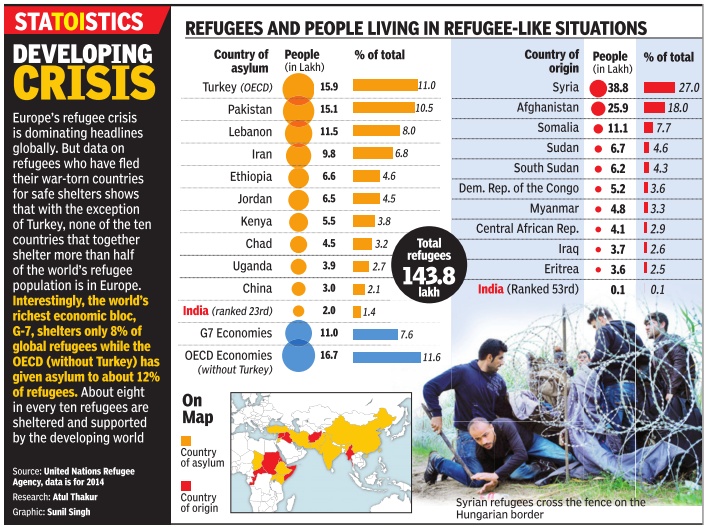
This is a collection of articles archived for the excellence of their content. |
Contents |
[edit] The global perspective
[edit] 1951-2016: periods of high and low refugee populations
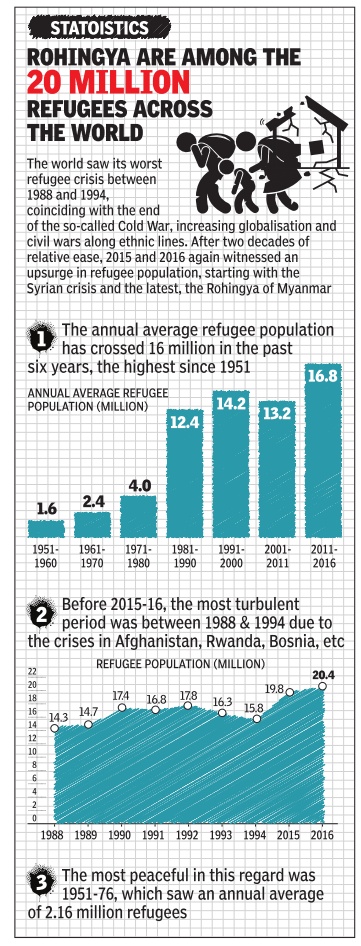
From: The Times of India, October 17, 2017
See graphic: 1951-2016- periods of high and low refugee populations, the global perspective
[edit] 2014: people displaced, worldwide
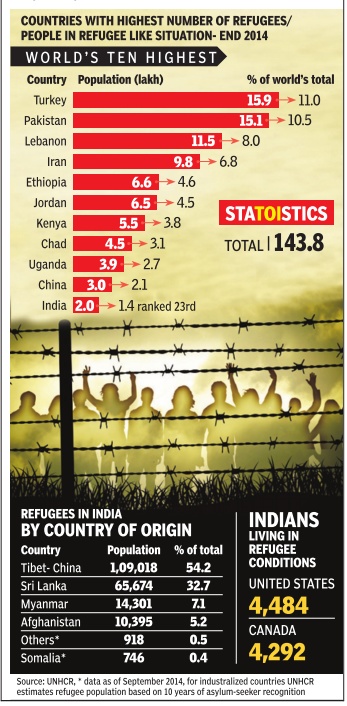
Jun 22 2015
By the end of 2014, about 60 million people were forcibly displaced worldwide because of persecution, conflict or human rights violation. There are three broad categories of displaced people--refugees, asylum-seekers and internally displaced. Of the total 14.4 million refugees or people living in such conditions, the largest chunk is in Turkey and Pakistan. Currently, India is home to about 2 lakh refugees, ranking 23rd on a list of countries with the highest refugee population. The largest number of people living in India as refugees, or in refugee-like condition is from Tibet and Sri Lanka. UNHCR's recently released report on forced displacement also states that over 8,000 Indians are living in refugee like situation in the US and Canada.
[edit] People fleeing violence in India and the world
[edit] 2020
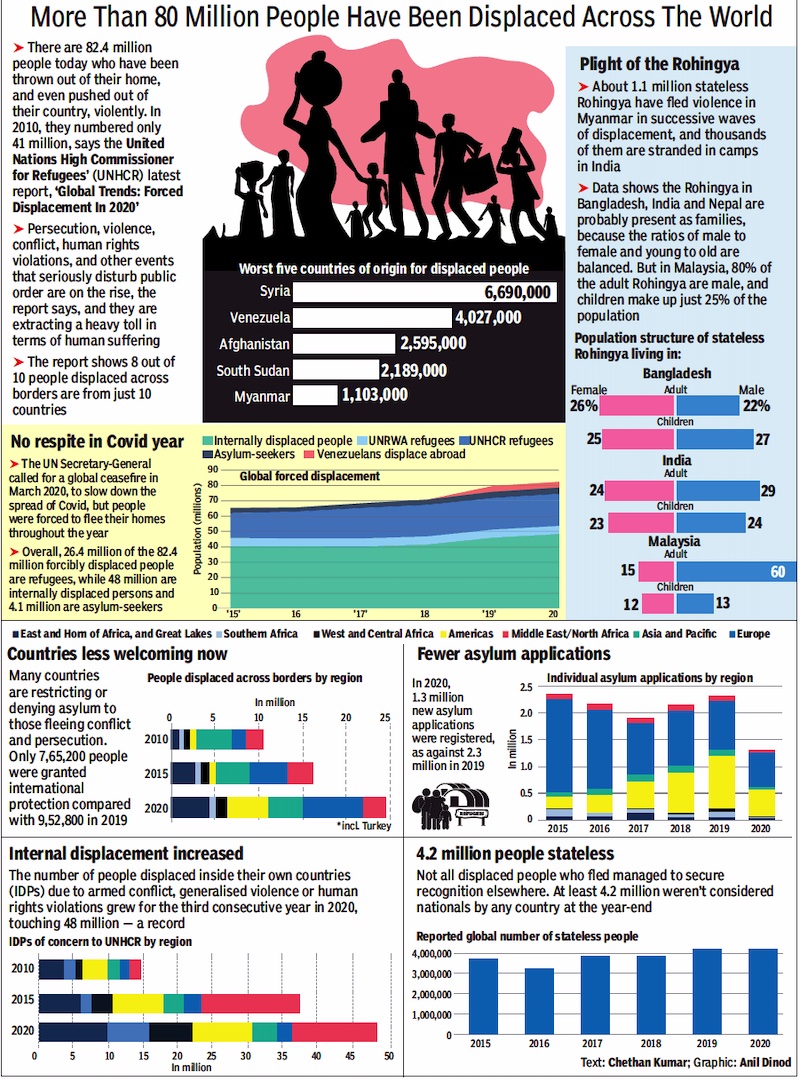
From: July 22, 2021: The Times of India
See graphic:
People fleeing violence in India, Afghanistan, Bangladesh, Myanmar and the world in 2020
[edit] India and refugees
[edit] The legal framework
What is the UNHCR and the 1951 convention on refugees? '
To deal with the European refugee crisis following the Second World War, a special UN conference held on July 28, 1951 passed the 1951 Convention on refugees. Initially , it was limited to protecting European refugees who had left their country before January 1, 1951. The United Nations High Commissioner for Refugees (UNHCR) was appointed as the guardian of the convention. A new protocol in 1967 removed the geographical and temporal limits and made it a global refugee agency . The convention has so far been ratified by 145 countries.
Who is a refugee and how are they protected under the convention?
The 1951 convention and the 1967 protocol relating to the status of refugees defines a refugee as someone who is unable or unwilling to return to their country of origin owing to a well-founded fear of being persecuted for reasons of race, religion, nationality, membership of a particular social group or political opinion. The convention protects refugees by non-discrimination, non-penalisation (for entering the country) and nonrefoulement (forcible return to a country where they are likely to face persecution). It also lays down basic minimum standards for treatment of refugees that include access to courts, primary education, refugee travel docu ments in passport form and so on. Under the convention, signatory states undertake to cooperate with the UNHCR in exercising its functions.
Why has India not signed the convention?
Initially formed to protect only European refugees, many experts saw the UNHCR and the convention in its earlier days as a tool of Western Europe to win the ideological battle against communism. In its early days, the agency mainly dealt with resettling political escapees from the communist bloc to show the failure of communism and the benevolence of the `free world'. India's foreign ministry is reported to have told the UNHCR in 1953 that the global refugee policy was part of the Cold War. India was also reported to have stated its reservations with a definition of refugee which doesn't identify the fundamental actors that cause the situation. Apart from this, signing the convention would mean mandatory cooperation with the UNHCR, which could be seen as losing some sovereign rights. India has faced a period of strained relationship with the agency during the Bangladesh refugee crisis and many experts argue that the legacy could al so be a hindrance in India signing the convention.
What happened during the Bangladesh refugee crisis?
In 1970, Zulfiqar Ali Bhutto's Pakistan's Peoples Party lost the elections to Sheikh Mujibur Rahman's Awami League. Politicians in West Pakistan were not willing to let Mujib lead the country and the inauguration to National assembly was cancelled by Yahya Khan, Pakistan's military dictator. This resulted in massive protests in East Pakistan brutally suppressed by Pakistan's army . Pakistan's use of ruthless force on its own people resulted in the world's largest refugee crisis. By the end of 1971, over 10 million East Pakistanis crossed the border fleeing persecution by the army , putting huge stress on India. India provided relief by setting up camps and providing food and medicines to the extent possible. Although aid was coming from Western countries, they were not willing to acknowledge the root cause of this problem because of Pakistan's proximity with the US. During this period, Sadruddin Aga Khan, the UNHCR head visited the subcontinent at the invitation of Yahya Khan and toured East Pakistan before visiting India. This visit was seen by India as UNHCR's endorsement of Pakistan's military government, which was responsible for the humanitarian crisis. As a result, the Indian government distanced itself from the agency .In a report on the 1971 crisis, the agency says it was not allowed to work in refugee camps as the Indian government was shielding its assistance to Mukti Bahini, the Bangladeshi guerrilla force.
How does India deal with refugees and what are the laws to protect them?
India has had an exemplary track record in protecting refugees. It has protected refugees from Tibet, Sri Lanka, Myanmar, Afghanistan and Bangladesh. During the 1971crisis, when 10 million refugees crossed the border, the government set up relief camps for 7 million while over 3 million were supported by host families. India, however, doesn't have any formal definition of refugees and they are largely dealt with by the Registration of Foreigners Act 1939, Foreigners Act 1946 and Passport Act 1967. The Indian constitution provides the right to equality before law and right to personal liberty to everyone living in India. India is signatory to various universal human right conventions against torture, child and women's rights abuse, racism and so on and these also protect refugees. Apart from this, the principle of non-refoulment mentioned earlier is widely accepted as a principle of international law.
[edit] Polish refugees: 1941-48
The Times of India, Apr 17 2016
At UN, India to display Guj handling of Polish refugees as a model for West
Sachin Parashar
In a world saddled with refugee crises, India will next week put on display at the UN an example from Gujarat to underscore the compassion which has marked its own handling of refugees in the past.
India's mission in New York headed by Syed Akbaruddin will on April 22 inaugurate an exhibition titled -Passage to India: The Wartime Odyssey of Polish Children and the Good Maharaja.Poland PM Beata Szydlo and Union minister Prakash Javadekar will attend the event The exhibition will depict a touching story from World War II of more than 1,000 Polish children, mostly orphans, deported from Poland to Siberia. These children, when allowed to leave Siberia in 1941-42, travelled all the way to India, where Mahara ja Jam Saheb Digvijaysinhji Ranjitsinhji of erstwhile Nawanagar created a new home for them in Balachadi, 25 km from his capital Jamnagar.
“When the world faces crises and large numbers of refugees and migrants seek their new homes, humanism and friendship between nations can go a long way in addressing crises, said Akbaruddin. By projecting Gujarat as a symbol for international goodwill, the government will also hope to undo some of the adverse publicity the state received in the West be cause of the sectarian strife witnessed there in the recent past. The Gujarat government under Narendra Modi in 2013 had helped Poland's ministry of culture and Doordarshan produce a documentary on the Polish children.
The Polish government has always been extremely appreciative of the fact that the Maharaja went out of his way to host the children at a time when India was struggling for its own independence. The Polish camps in Balachadi and Valivade (now in Maharashtra) flourished un til the last of the Polish families left India in 1948.
The Maharaja, who was nephew of renowned Indian cricketer Ranjitsinhji Vibhaji Jadeja, while adopting the Polish children, had famously said, “Do not consider yourself orphans. You are now Nawnagaris and I am Bapu, father of all the people of Nawanagar, so also yours.
The exhibition has been designed by Polish historian Robert Kostro.
Despite its large refugee population, India has not yet signed the 1951 UN Refugee Convention. The exhibition on Polish children will closely follow the successful commemoration of Ambedkar's 125th birth anniversary . This was the first time his birth anniversary had been celebrated at the UN. “It is a matter of great pride for India that Dr Ambedkar's birth anniversary was observed at @UN,“ Modi tweeted after the event.
[edit] Those given refuge in India
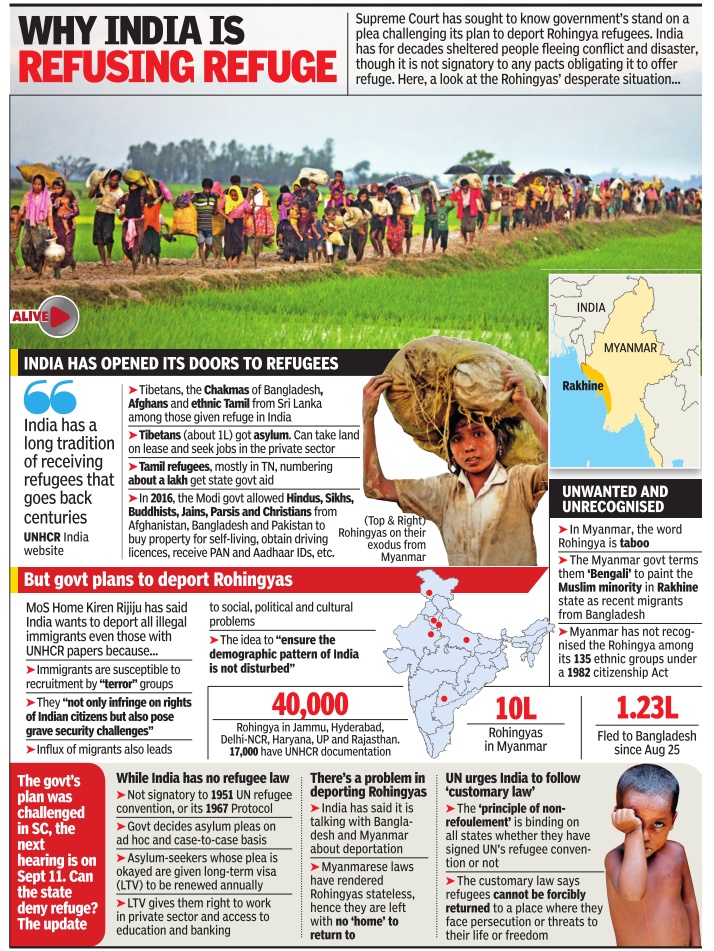
ii) India and the UN’s refugee conventions
From The Times of India, September 6, 2017
See graphic, Those given refuge in India after 1947; India and the UN’s refugee conventions